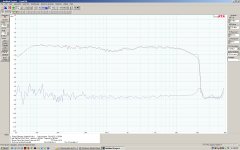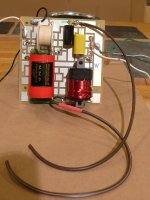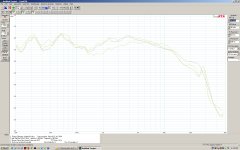I tried measuring my ER18s on the weekend, but the cold weather & my hangover prevented me form getting consistent results, however they were similar to previous mesurements.
I also retuned my ports to 42Hz, this made a huge difference, the speakers now have a much more full-bodied sound, and this is without any BSC at all. Unfortunately I had visitors so couldn't do any detailed listening, but from what I heard I think they'll make a good pair of 2 way monitors, even if they don't have the fullness of bass that a larger driver could deliver.
I also retuned my ports to 42Hz, this made a huge difference, the speakers now have a much more full-bodied sound, and this is without any BSC at all. Unfortunately I had visitors so couldn't do any detailed listening, but from what I heard I think they'll make a good pair of 2 way monitors, even if they don't have the fullness of bass that a larger driver could deliver.
Spoken like a true DIY addict 😀Unfortunately I had visitors so couldn't do any detailed listening
I have a 3 set of Vifa M 18WO-09-08; 7"
They have great bass, easy to work with also.
(They stopped making them)
They have great bass, easy to work with also.
(They stopped making them)
after a listening session... very happy how these turned out, still have a bit of 'forwardness' to the sound, & they don't do the bass fundamentals of a larger driver, but they're pretty well balanced, I'm enjoying them & I've had no urge to change to my larger system, or even connect up the .5 way woofers...
I've only got a .68mH coil in series with the woofer (+ notch fliter), perhaps that'll be upsized one day (anyone notice any squiggles in their impedance plots at ~1Khz?) but for the moment I'm just gonna sit back & enjoy
I've only got a .68mH coil in series with the woofer (+ notch fliter), perhaps that'll be upsized one day (anyone notice any squiggles in their impedance plots at ~1Khz?) but for the moment I'm just gonna sit back & enjoy
I can sure see why some are not happy with this. First, I can tell already, I really like this woofer.
In the included plots, it shows the nearfield for both the soft dome SR71 tweeter, and the otherwise similar metal dome. The lower plot is 1M on axis. Note the rising top end. When I drape a heavy bath towel over it , it starts to sound really good. I think John stopped too soon with the crossover. The hump at 20K is interesting. I have not run across that before.
The reason I am playing with this in the first place is the differences in metal vs. soft domes. It is quite surprising how dramatic a difference the sound is between the two and how little shows up in the graph.
In the included plots, it shows the nearfield for both the soft dome SR71 tweeter, and the otherwise similar metal dome. The lower plot is 1M on axis. Note the rising top end. When I drape a heavy bath towel over it , it starts to sound really good. I think John stopped too soon with the crossover. The hump at 20K is interesting. I have not run across that before.
The reason I am playing with this in the first place is the differences in metal vs. soft domes. It is quite surprising how dramatic a difference the sound is between the two and how little shows up in the graph.
Attachments
So you've got roughly a 1dB difference from ~3.5k-~10k, with some minor changes in the top octave. That might not sound like a lot, but a change like that can make quite a difference to a loudspeakers tonal balance.
As far as I can see John's design is fine the way that it is, especially as his tweeter level options would help adjust the tonal balance fairly well. Tweeters can also vary a little in their sensitivity and responses, so can microphones and measurement systems. But a small rise, such as you've experienced, isn't too much of a surprise, especially as the tweeter has a small rising top end as it is.
The hump just above 20k is a little surprising though, especially as it doesn't show up at all in the near-field plot. The near-field plots however sink like a stone just above 20khz and the far-field extend right up to 50k which suggests that the hard-ware or software settings weren't identical between the two, so maybe making a comparison between the two isn't valid.
As far as I can see John's design is fine the way that it is, especially as his tweeter level options would help adjust the tonal balance fairly well. Tweeters can also vary a little in their sensitivity and responses, so can microphones and measurement systems. But a small rise, such as you've experienced, isn't too much of a surprise, especially as the tweeter has a small rising top end as it is.
The hump just above 20k is a little surprising though, especially as it doesn't show up at all in the near-field plot. The near-field plots however sink like a stone just above 20khz and the far-field extend right up to 50k which suggests that the hard-ware or software settings weren't identical between the two, so maybe making a comparison between the two isn't valid.
Settings are identical. I just moved the mic stand. Mic is calibrated. What I hear matched what I measure. I have not pulled out my pulse tester or fired up Sound Easy to look at phase and offset issues. This was using the TrueRta "quick sweep" which is usually reasonably trustworthy.
If all you did was move the mics position then I'd be wanting to try and explain the differences apparent in the near and farfield ones. Sure the mic position can easily explain why you get a slightly drooping response in the nearfield and then a rising in the farfield, but that relatively huge hump at a little over 20k and then the fact the farfield response seems to extent all the way up to 50k, something isn't quite right there.
Either way what this looks like to me is a situation where the tweeter level is set slightly too high. If you look again at the nearfield response you will see that the response hits a minimum at around 1300Hz and then to the left of it, it slowly rises. This is most likely due to the baffle steep compensation bringing the bass up too high due to the nearfield environment. Then to the right of around 1300Hz-3kHz the output rises. The uneveness of the response around this area is probably due to less then perfect phase tracking with the mic being so close and the rise in the tweeter response is probably due to a slightly high tweeter output coupled with the mic perhaps being closer to the tweeter so its output is seen again as being slightly too high.
If you look at the farfield response you will see that the rise created by the baffle step compensation has now disappeared, this you would expect and most of the uneveness/tweeter level issues, have gone away, but you're left with a slightly rising response. I'd simply try padding the tweeter down by a dB and see what happens.
Either way what this looks like to me is a situation where the tweeter level is set slightly too high. If you look again at the nearfield response you will see that the response hits a minimum at around 1300Hz and then to the left of it, it slowly rises. This is most likely due to the baffle steep compensation bringing the bass up too high due to the nearfield environment. Then to the right of around 1300Hz-3kHz the output rises. The uneveness of the response around this area is probably due to less then perfect phase tracking with the mic being so close and the rise in the tweeter response is probably due to a slightly high tweeter output coupled with the mic perhaps being closer to the tweeter so its output is seen again as being slightly too high.
If you look at the farfield response you will see that the rise created by the baffle step compensation has now disappeared, this you would expect and most of the uneveness/tweeter level issues, have gone away, but you're left with a slightly rising response. I'd simply try padding the tweeter down by a dB and see what happens.
I am using the Madisound supplied crossover built to John's spec; so no baffle compensation. Not really worried about that as this is a test box slightly slightly wide to get two tweeters in it. Both carefully the same center to center from the woofer. Anyway, just ignoring everything below 1500. All measurements are taken in line with the tweeter.
Now the fun begins. I kind of have to think, something changed since the original design.
I'll have to sleep on that hump. I agree that nothing makes sense but a measurement anomaly, but I have made hundreds of measurements and never seen such a thing. The other thing I find odd is how small the metal tweeter breakup is compared to when I was working with it by its self. As expected, the metal dome is a tad flatter and a tad more extended, but the fabric does not have the breakup at 26K. ( green vs purple traces)
Now the fun begins. I kind of have to think, something changed since the original design.
I'll have to sleep on that hump. I agree that nothing makes sense but a measurement anomaly, but I have made hundreds of measurements and never seen such a thing. The other thing I find odd is how small the metal tweeter breakup is compared to when I was working with it by its self. As expected, the metal dome is a tad flatter and a tad more extended, but the fabric does not have the breakup at 26K. ( green vs purple traces)
I felt the tweeter was too high - or the lead lining over dampened the woofer (my idea). I ended up padding the tweeter with an L pad😱
MY buddy loves them (that's who I made these for). He wants a Zaph 3-way next.
He bought a 2.1 receiver to run them with, he loves that also.
MY buddy loves them (that's who I made these for). He wants a Zaph 3-way next.
He bought a 2.1 receiver to run them with, he loves that also.
If all you did was move the mics position then I'd be wanting to try and explain the differences apparent in the near and farfield ones. Sure the mic position can easily explain why you get a slightly drooping response in the nearfield and then a rising in the farfield, but that relatively huge hump at a little over 20k and then the fact the farfield response seems to extent all the way up to 50k, something isn't quite right there.
Either way what this looks like to me is a situation where the tweeter level is set slightly too high. If you look again at the nearfield response you will see that the response hits a minimum at around 1300Hz and then to the left of it, it slowly rises. This is most likely due to the baffle steep compensation bringing the bass up too high due to the nearfield environment. Then to the right of around 1300Hz-3kHz the output rises. The uneveness of the response around this area is probably due to less then perfect phase tracking with the mic being so close and the rise in the tweeter response is probably due to a slightly high tweeter output coupled with the mic perhaps being closer to the tweeter so its output is seen again as being slightly too high.
If you look at the farfield response you will see that the rise created by the baffle step compensation has now disappeared, this you would expect and most of the uneveness/tweeter level issues, have gone away, but you're left with a slightly rising response. I'd simply try padding the tweeter down by a dB and see what happens.
Attachments
I am using the Madisound supplied crossover built to John's spec; so no baffle compensation.
The Madisound supplied crossover includes bafflestep compensation as it's there as standard in John's design and as far as I can see Madisound don't offer a 'reduced bafflestep' version either.
I felt the tweeter was too high - or the lead lining over dampened the woofer (my idea). I ended up padding the tweeter with an L pad😱
I don't know why you'd feel it necessary to add in an L-pad, which could quite easily alter how the crossovers function, John does, after all, provide you with different tweeter level options on his website.
I was starting to think that may have been an option back then (last year); no one metioned that when I called MS.
Sho-nuff.
Today, no mystery 20K hump. Nothing changed I can identify other than a reboot. I brought in one of my Paradigm Studio 20's. The following are 2M "quick sweep" Yellow is the Paradigm, Brown is the metal dome Seas and green is the cloth dome Seas version as specified in the SR-71.
What this shows is both the metal domes have the breakup that I believe is the source of my problem and how otherwise close the two Seas tweeters are to each other. There is likely too much room interference at 2M to make any comments on smoothness. At nearfield, the Paradigm has quite a dip at the crossover point but is flatter in the top registers. SR71 sounds tons brighter. Anyway, measurements make sense so on to playing with the crossovers. I'll start with upping the 4 Ohm to 5.
There is no separate BSC; you are most correct he designed it into the HP filter by playing with F and Q a bit. Even if I find it way too bright, he is no fool. Sound Easy helps with that. Again, for this test, I don't care. It depends on where I wind up using them if I need to worry about that, providing the problem is metal tweeters and once padded a tad, the nicely behaved soft dome solves the problem. If not, Fostex and Fountec are on order as mids.
Today, no mystery 20K hump. Nothing changed I can identify other than a reboot. I brought in one of my Paradigm Studio 20's. The following are 2M "quick sweep" Yellow is the Paradigm, Brown is the metal dome Seas and green is the cloth dome Seas version as specified in the SR-71.
What this shows is both the metal domes have the breakup that I believe is the source of my problem and how otherwise close the two Seas tweeters are to each other. There is likely too much room interference at 2M to make any comments on smoothness. At nearfield, the Paradigm has quite a dip at the crossover point but is flatter in the top registers. SR71 sounds tons brighter. Anyway, measurements make sense so on to playing with the crossovers. I'll start with upping the 4 Ohm to 5.
There is no separate BSC; you are most correct he designed it into the HP filter by playing with F and Q a bit. Even if I find it way too bright, he is no fool. Sound Easy helps with that. Again, for this test, I don't care. It depends on where I wind up using them if I need to worry about that, providing the problem is metal tweeters and once padded a tad, the nicely behaved soft dome solves the problem. If not, Fostex and Fountec are on order as mids.
Attachments
Bafflestep correction is dialled into the low pass filter on the mid/bass. You can opt for a lower amount of BSC by unwinding the primary inductor, this is detailed in John's design, along with the increased tweeter output necessary if you choose to use the lower BSC option.
5 Ohms. Me like. It is easier to hear the differences between the two tweeters. Harry James is still a little rough. On to Segovia, Grusin, and Baez
Joni Mitchel, proof it is still a bit bright. Actually very nice with a medium bath towel instead of the heavy terry bath mat as a grill cloth.
Well that would make some sense, as your previous farfield measurement showed that the tweeter level was matched pretty decently to the mid/bass, only it had a bit of a rise in the last octave or so. Reducing the value of R5 will reduce the top octave rise, but it will also add in a small broad hump at around 5kHz.
Faffing around with R0 and R5 till you get the tonal balance right is exactly what Zaph wants you to do with this design though.
Faffing around with R0 and R5 till you get the tonal balance right is exactly what Zaph wants you to do with this design though.
- Status
- Not open for further replies.
- Home
- Loudspeakers
- Multi-Way
- Zaph Audio ZA-SR71 Review!



